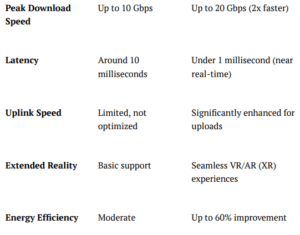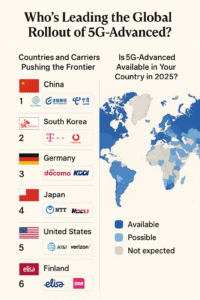 5G-Advanced marks an exciting leap forward in mobile technology, ushering in
5G-Advanced marks an exciting leap forward in mobile technology, ushering in
smarter networks, improved efficiency, and a host of powerful new features. As 5G
continues to gain traction around the globe, the telecom industry is already setting
its sights on what lies ahead. Acting as a crucial link between existing 5G networks
and the upcoming 6G systems, 5G-Advanced is poised to transform the industry
with faster speeds, reduced energy consumption, AI-driven automation, and
practical applications designed for various sectors. With rollouts anticipated to
ramp up in 2025, this evolution is more than just an upgrade — it’s a sneak peek into
our connected future.
What Is 5G-Advanced and Why It Matters in 2025
Think of 5G-Advanced as the “smart upgrade” to the 5G you’ve been hearing about for years — but with a lot more brainpower and possibilities. It’s not a brand-new network like 6G, nor is it the same 5G your phone might already be using. Instead, it’s the next step forward, bridging the gap between today’s 5G and the future vision of 6G, packed with massive improvements that most people don’t even notice are happening. Our digital lives are expanding rapidly. We’re engaging online more than ever, using a variety of devices in increasingly complex ways. 5G-Advanced ensures our networks not only keep pace but actually lead the way. Whether you’re streaming high-definition content, managing smart home devices, or running a business from afar, 5G-Advanced is the unseen force making everything smoother, faster, and ready for the future. And here’s the kicker: it’s already being rolled out in many countries, yet very few people even know it’s out there. So if you’re reading this, congratulations — you’re already ahead of the game!
➢The Evolution from 5G to 5G-Advanced (3GPP Release 18)
5G-Advanced is like the next step up from standard 5G, officially recognized by 3GPP in Release 18. You can think of it as 5G’s smarter, high-performance sibling — it’s not here to replace 5G, but to enhance it.
While the original 5G brought us faster speeds compared to 4G, 5G-Advanced takes things a step further by adding intelligence to the network with features like:
● Integrated AI/ML for network self-optimization
● Extended reality (XR) support for VR/AR experiences
● Enhanced uplink speeds — a major boost for content creators
● Precision location services down to centimeters
➢Why 5G-Advanced Is More Than Just a Speed Upgrade
The leap from 5G to 5G-Advanced isn’t just another tech spec bump — it’s a complete reimagining of how networks think, respond, and scale. Let’s unpack what that means.
Speed, Latency & Real-World Performance
Feature 5G 5G Advanced
 Why it matters:
Why it matters:
5G has improved our streaming and download speeds, but 5G-Advanced takes things
to a whole new level — it brings instant responsiveness into the mix. We’re talking
About real-time control systems, such as:
● Remote surgeries, where every millisecond is crucial
● Autonomous vehicles that must process and react on the fly
● – Cloud gaming and VR, where even the slightest delay can spoil the fun
This isn’t just about faster browsing; it’s about ensuring reliability when it really
matters.
🧠AI, Network Efficiency & Future Scalability
One of the standout features of 5G-Advanced is its AI-native core. This innovative technology enables the network to:
● Adjust bandwidth on the fly, depending on how much is being used.
● Anticipate and prevent congestion before it becomes a problem.
● – Give priority to essential applications over less important background data.
In short, it’s like having a self-aware network, paving the way for a fully autonomous 6G future.
Core Features That Make 5G-Advanced a Game Changer

Let’s dive deeper into the core technologies that make 5G-Advanced more than a basic upgrade.
➢Smart Network Optimization & Energy Savings
One of the most impressive features of 5G Advanced is its built-in intelligence. This network doesn’t just transmit data — it actually thinks! Thanks to AI-driven optimization, it can automatically tweak bandwidth, ease congestion, and lower power consumption when demand is light. The result? Up to 60% better energy efficiency, which means your devices can last longer and networks can operate in a
more eco-friendly way. It’s not just smart; it’s also sustainable!
➢Enhanced IoT & Industrial Applications
5G-Advanced is designed specifically for the Industrial Internet of Things (IIoT)
● powering factories filled with thousands of sensors.
● enabling autonomous delivery fleets.
● and facilitating remote-controlled mining and logistics operations.
Its ultra-reliable low-latency communication (URLLC) allows for precision-level
control that earlier networks simply can’t achieve.
 You might already be using 5G-Advanced — even if you don’t know it.
You might already be using 5G-Advanced — even if you don’t know it.
➢From Remote Surgeries to Smart Cities
In 2025, 5G-Advanced is making waves by enabling:
● Remote robotic surgeries in India and South Korea
● AI-managed traffic signals in Singapore and Germany
● Augmented reality training systems in medical schools and military bases
What ties these together? They all involve mission-critical tasks—situations where even a split-second delay could spell disaster.
➢What This Means for Consumers and Businesses
For you, this means:
● Enjoy flawless 4K mobile streaming, even in the busiest stadiums.
● Having smoother video calls, even when the signal is weak.
● Experiencing AR-enhanced shopping, tourism, and live events.
For businesses, it translates to automated workflows, reduced data costs, and the ability to make real-time decisions powered by edge computing.
How 5G-Advanced Bridges the Gap to 6G
You might be wondering: “If 6G is coming, should I skip 5G-Advanced?” Short answer: No. Here’s why.
➢Laying the Foundation for AI-Native 6G
5G-Advanced is essentially the training ground for 6G. The tools, infrastructure, and AI integration we’re introducing now will seamlessly transition into the high-frequency, holographic communication systems that we expect to see around 2030. Skipping this phase would be like trying to leap from 3 G straight to 5G — you’d miss out on essential functionality and the readiness of the ecosystem.
➢Should You Wait for 6G or Upgrade Now?
Let’s be real, we probably won’t see 6G in our hands until 2030 or even later. In the meantime, 5G-Advanced is set to take the lead in mobile and industrial networks for the next 5 to 7 years. If your device, city, or carrier is ready for it, don’t wait—upgrade now! You’ll gain access to more features with each firmware update.
Who’s Leading the Global Rollout of 5 G-Advanced?
 The 5G-Advanced race is heating up globally — and not where you might expect.
The 5G-Advanced race is heating up globally — and not where you might expect.
➢Countries and Carriers Pushing the Frontier
According to the 2025 reports:
● India, the USA, and the UK lead in consumer adoption
● South Korea, Germany, and China dominate industrial deployment.
● The UAE is a rising player in smart city infrastructure.
Carriers like Airtel, Verizon, T-Mobile, SK Telecom, and Deutsche Telekom are rolling out 5G-Advanced-ready plans in over 40 countries.
➢Is 5 G-Advanced Available in Your Country in 2025?
Absolutely! If your carrier just rolled out 5G, there’s a good chance you already have access to 5G-Advanced. Most flagship phones from 2023 and beyond are equipped to handle it, and carriers are quietly enhancing their networks in cities, airports, and tech hubs. Just make sure to update your device software, check if your plan supports 5 G-A, and give your phone a quick restart. Keep an eye out for indicators like “5G++” or “5G-A-A.” Countries such as China, South Korea, the U.S., and various
parts of Europe and the Middle East are already gearing up for active 5G-Advanced zones by 2025.
Final Verdict: Should You Care About 5 G-Advanced Right Now?
➢Future-Proofing Your Devices
If you’re in the market for a new phone, opting for one that supports 5 G-Advanced isn’t just a flashy choice—it’s a smart decision. With quicker speeds, reduced latency, and improved battery life, 5G-A devices are built to last. As networks continue to advance, older models may find it hard to keep pace, which could lead to annoying slowdowns or even the need for an upgrade sooner than you’d like.
➢Why Ignoring 5G-Advanced Could Cost You More Later
Skipping out on 5G-Advanced today might feel like no big deal, but just wait until tomorrow when apps, games, and updates start craving that extra speed and stability. If you hold off for too long, you might find yourself facing an expensive upgrade sooner than you thought!
Conclusion: 5G-Advanced Is Already Here — Are You Ready?
5G-Advanced isn’t some distant tech fantasy — it’s quietly rolling out in your city, your phone, and your everyday life. Whether you’re streaming, gaming, or building the next big app, this isn’t just about speed — it’s about unlocking new possibilities. The gap between 5G and 5G-Advanced is where the real leap happens. If you’re not paying attention now, you might be playing catch-up tomorrow. The future is dialing in — are you picking up?

